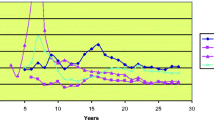Abstract
The structure of the coronary prone behavior syndrome was mapped onto the personality trait domain with a sample of 222 adult men and women (mean age=31). The subjects completed the Sixteen Personality Factor (16PF) and the Jenkins Activity Survey (JAS) questionnaires and canonical correlation analysis was used to derive the structure of common variance between the two sets of scales. Coronary prone behavior, when viewed within personality source trait structure, can be thought of as heavily influenced by anxiety and extraversion. Additional regression analyses were conducted to analyze interdomain relationships among the 16PF and JAS.
Similar content being viewed by others
References
Alexander, F. (1950).Psychosomatic medicine. New York: Norton.
Buros, O. K. (1978).The eighth mental measurement yearbook. Highland Park, New Jersey: Gryphon.
Cattell, R. B., Eber, H. W., and Tatsuoka, M. M. (1970).Handbook for the 16PF. Champaign: IPAT.
Cattell, R. B., and Scheier, I. H. (1961).The meaning and measurement of neuroticism and anxiety. New York: Ronald Press.
Diamond, G. A., Forrester, J. S., Hirsch, M., Staniloff, H. M., Vas, R., Berman, D. S., and Swan, H. J. C. (1980). Application of conditional probability analysis to the clinical diagnosis of coronary artery disease.Journal of Clinical Investigation, 65, 1210–1221.
Dunbar, F. (1947).Mind and body: Psychosomatic medicine. New York: Random House.
Friedman, M. and Rosenman, R. H. (1974).Type A behavior and your heart. New York: Knopf.
Gillis, J. S. (1980).Child Anxiety Scale Manual. Champaign: IPAT.
Guilford, J. P. (1965).Fundamental statistics in psychology and education. New York: McGraw-Hill.
Halliday, J. L. (1943). Concept of a psychosomatic affection,Lancet, 246, 692.
Harmon, H. H. (1960).Modern factor analysis. Chicago: University of Chicago Press.
Horn, J. L., Wanberg, J. W., and Appel, M. (1973). On the internal structure of the MMPI.Multivariate Behavioral Research, 8, 131–171.
Hussong, M. A., Sherman, J. L., and Ferris, G. R. (1977).16PF research bibliography: 1971–1976. Champaign: IPAT.
IPAT Staff. (1979).Administrator's manual for the 16PF. Champaign: IPAT.
Jenkins, C. D. (1971). Psychologic and social precursors of coronary disease.New England Journal of Medicine, 284, 244–255.
Jenkins, C. D. (1976). Recent evidence supporting psychologic and social risk factors for coronary disease.New England Journal of Medicine, 294, 987–994.
Jenkins, C. D., Zyzanski, S. J., and Rosenman, R. H. (1979).Jenkins Activity Survey. New York: Psychological Corporation.
Karson, S. and O'Dell, J. W. (1977). Identifying medical risk factors in the 16PF profile: A clinical approach. In S. E. Krug (Ed.),Psychological assessment in medicine. Champaign: IPAT.
Kozoll, C. (1982).Time wise: An individualized program for managing time. (Champaign: IPAT.
Krug, S. E. (1981).Interpreting 16PF profile patterns. Champaign: IPAT.
Krug, S. E., Cattell, R. B., and Scheier, I. H. (1976).Handbook for the IPAT Anxiety Scale. Champaign: IPAT.
Lynn, R. (1975). National differences in extraversion and neuroticism.British Journal of Social and Clinical Psychology, 4, 223–240.
Segers, M. J. and Mertens, C. (1974). Psychological and bioclinical CHD risk factors: Quantitative differences between obese, normal, and thin subjects.Journal of Psychosomatic Research, 18, 403–411.
Segers, M. J. and Mertens, C. (1976). Relationships between anxiety, depression self-ratings and CHD risk factors among obese, normal and lean individuals.Journal of Psychosomatic Research, 20, 25–35.
Segers, M. J. and Mertens, C. (1977). Personality aspects of CHD related behavior.Journal of Psychosomatic Research, 21, 79–85.
Sherman, J. L. and Krug, S. E. (1977). Personality-somatic interactions: The research evidence. In S. B. Krug (Ed.),Psychological assessment in medicine. Champaign: IPAT.
Skidmore, S. (1977). Translating psychological profiles into treatment procedures. In S. E. Krug (Ed.),Psychological assessment in medicine. Champaign: IPAT.
Stewart, D. K. and Love, W. A. (1968). A general canonical correlation index.Psychological Bulletin, 70, 160–163.
Tatsuoka, M. M. (1976).Validation studies: The use of multiple regression equations. Champaign: IPAT.
Author information
Authors and Affiliations
Rights and permissions
About this article
Cite this article
Krug, S.E., Johns, E.F. Personality factors underlying coronary prone behavior patterns among employees. J Bus Psychol 1, 124–133 (1986). https://doi.org/10.1007/BF01018808
Issue Date:
DOI: https://doi.org/10.1007/BF01018808




